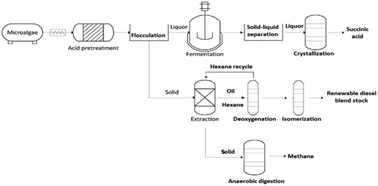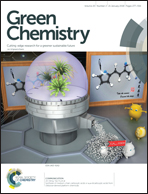Demonstration of parallel algal processing: production of renewable diesel blendstock and a high-value chemical intermediate
Abstract
Co-production of high-value chemicals such as succinic acid from algal sugars is a promising route to enabling conversion of algal lipids to a renewable diesel blendstock. Biomass from the green alga Scenedesmus acutus was acid pretreated and the resulting slurry separated into its solid and liquor components using charged polyamide induced flocculation and vacuum filtration. Over the course of a subsequent 756 hours continuous fermentation of the algal liquor with Actinobacillus succinogenes 130Z, we achieved maximum productivity, process conversion yield, and titer of 1.1 g L−1 h−1, 0.7 g g−1 total sugars, and 30.5 g L−1 respectively. Succinic acid was recovered from fermentation media with a yield of 60% at 98.4% purity while lipids were recovered from the flocculated cake at 83% yield with subsequent conversion through deoxygenation and hydroisomerization to a renewable diesel blendstock. This work is a first-of-its-kind demonstration of a novel integrated conversion process for algal biomass to produce fuel and chemical products of sufficient quality to be blend-ready feedstocks for further processing.



 Please wait while we load your content...
Please wait while we load your content...